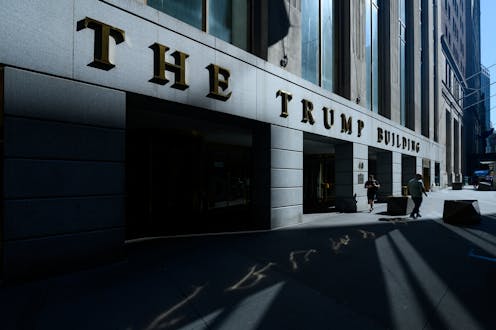Trump properties aren't the only ones to see wild valuations – putting a price on real estate isn't
What is real estate actually worth? It depends a lot on who you ask and what method they use to work it out.

On the lower tip of Manhattan there is a prime piece of real estate, the price of which is somewhat up for debate.
To the owners, the Trump Organization, 40 Wall Street is worth an eye-watering US$735 million, or at least it was in 2015. Others disagree, pointing to an appraisal that year by a real estate firm that priced it at $540 million. But even that was inflated, according to the New York attorney general: An appraisal three years earlier suggested the worth of the property then was $220 million.
The probe into the alleged fraudulent activities relating to Donald Trump’s property empire has many people wondering about the art and science of real estate valuations. Even when there are no claims of fraud involved, valuations can vary widely – and it is a longstanding problem. This likely sets the bar high for New York’s civil lawsuit to prove its charge, that at least some valuations were fraudulent as opposed to “business as usual.”
In a 1987 experiment, experienced real estate agents were handed identical information regarding a typical house and asked to estimate its value, with the only difference being the listing price. The resulting valuations differed significantly. With commercial property, the large divergence in valuations has likewise long been recognized as a concern.

So why do real estate values seem so subjective? As someone who researches real estate trends, I know the practice is more art than science. Valuations are educated opinions. They are based on some degree of factual information, but not facts in themselves. Expert valuations vary based on differing judgments of the same data. And when it comes to commercial real estate, experts even disagree over the methods involved.
The 3 ways to value property
Before delving deeper, some valuation basics: There are three overarching ways to value commercial real estate – the cost, the market and the income approaches.
The cost and market approaches are both based on the economic principle of substitution, which equates the value of real estate to the cost to create or acquire a substitute property of comparable utility. For example, an office value estimate of $200 per square foot is reasonable if it costs this amount to purchase an existing comparable office or to newly construct one.
The income approach is based on anticipation of future benefits, which equates the value of real estate to the income stream the property can generate. So a rented office that earns its owner $2 million a year in net income could reasonably be worth about twice the value of an office with $1 million a year in net income.
Appraisers use all three approaches when possible to value a property. Though commercial properties by necessity lean heavily on the income approach to mimic investors, it is also the most prone to value differences because it requires a crystal ball to accurately estimate future income.
Built on assumptions
Even when appraisers use the same approach and methods, there is ample room for difference. All three valuation approaches require assumptions, which provide fertile ground for expert disagreement.
The cost approach requires an estimation of depreciation and obsolescence and a way to value the land that the building sits on. Depreciation refers to the physical aging of the property. Obsolescence accounts for trends and market conditions that erode the property’s desirability, such as an outdated building design or an increase in neighborhood crime.
The market approach is limited to past sales that require adjustments to reflect such factors, beyond timing, as any difference in the desirability of a location or the physical condition of a sale property relative to the appraised property. km: I edited to correct meaning here — suggested edits had changed meaning.
Meanwhile, the income approach requires the appraiser to make assumptions on a property’s future income stream. Appraisers will typically consider market rents and, for property like hotels that operate as a business, historic income and expenses.
The pandemic made these various assumptions much more speculative due to uncertainty over the future use of office space. Even a property’s location as an influence on real estate value is no longer straightforward. My research points to shifting perspectives on what is deemed a quality location, with real estate premiums associated with central business districts becoming dubious as more people work remotely.
Experts also disagree over which aspects of real estate to include in a valuation. Real estate that generates income has components beyond the actual land and improvements to it. Elements that contribute to generating income but are not “real property” – things such as furnishings and a hotel’s brand recognition – need to be stripped out of the valuation for some purposes.
Valuations for tax purposes generally focus on real property value, while valuations for lenders tend to include more of these other real estate components.
Consider hotels as an example. It is generally accepted that the hotel’s brand and its furniture, fixtures and equipment are not real property, yet they have big implications for its value.
Influencing assessments
Commercial real estate does not offer the transparent pricing structure built into some assets like stocks.
Real estate is less frequently traded and sales go through a number of intermediaries, and much of the information surrounding a sale is not publicly shared. As a result, buyers do not have an easy benchmark for price comparison – it is like trying to decipher the going price for a hip replacement or a piece of fine art.
Furthermore, no two pieces of real estate are precisely the same. Commercial real estate assets vary in a multitude of attributes – such as location, condition, permitted uses and existing lease obligations – that affect potential income.
Indeed, research shows many commercial properties are listed for sale with no stated asking price because of the difficulty in determining potential revenue, which can vary based on what a given buyer plans to do with the property.
And sellers do not want to inadvertently underprice their asset. Take, for example, the 2014 sale of the Waldorf Astoria hotel in New York. The buyer, a Chinese company, deliberately paid a higher price than local investors might because they thought they could reap higher income through converting some space into luxury condos for Chinese buyers. The plan ultimately hit some snags, but it nonetheless justified a larger purchase price.
Rules and regulations
The uncertainty inherent in real estate values also leaves appraisers vulnerable to client influence.
A 2015 study in the U.K. examined appraisal values for institutional real estate funds and found that their valuation methods arbitrarily changed depending on what kinds of valuations the fund clients seemingly preferred.
So what does this all mean for Trump’s properties? Clearly real estate valuations aren’t a science, but it’s not the Wild West either. Appraisers are expected to follow regulatory standards, certification and licensing requirements and professional norms in the valuation of real estate. The question for the courts hearing the case of Trump properties is whether someone failed to follow them.
Kimberly Merriman does not work for, consult, own shares in or receive funding from any company or organization that would benefit from this article, and has disclosed no relevant affiliations beyond their academic appointment.
Read These Next
Midlife weight gain can start long before menopause – but you can take steps early on to help your b
What you do in the years leading up to menopause can help counter the natural hormonal effects of aging,…
Who thinks Republicans will suffer in the 2026 midterms? Republican members of Congress
The president’s party almost always loses seats in the midterms. More than two dozen Republican House…
Deepfakes leveled up in 2025 – here’s what’s coming next
After a year of fast advances, deepfakes are entering a new era defined by real-time interaction with…






